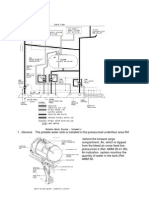Components-of-Flow-and-Level-Sensor-Trainer
Uploaded by
ssamyang92Components-of-Flow-and-Level-Sensor-Trainer
Uploaded by
ssamyang92· Flow Sensor – Measures the flow rate of water in the system.
· Level Sensor – Detects water levels in the tank.
· Power Supply – Provides the necessary voltage to the system.
· Circuit Breaker – Protects the circuit from overcurrent or short
circuits.
· Fuse – Adds extra protection to electrical circuits.
· Water Tank (2x) – Holds water for level measurement experiments.
· Valve (Manual or Motorized) – Controls the flow of water.
· Programmable Logic Controller (PLC) – Controls the operation of
sensors and actuators.
· Transparent Pipe – Allows visual observation of water flow.
· Water Pump – Circulates water through the system.
· Emergency Stop Button – Instantly shuts down the system for safety
in case of malfunction.
emergency shutdown in your Flow-and-Level Sensor Trainer by:
1. Activating an Alarm – If water levels or flow rates go beyond safe limits, the relay can trigger
buzzers or indicator lamps.
2. Cutting Off the Pump – In emergency conditions (e.g., dry running, overcurrent), the relay
can immediately disconnect power to the pump.
3. Integrating with Emergency Stop (E-Stop) Button – Pressing the E-Stop can trigger the relay
to shut down the system for safety.
· Relay Module – Acts as an intermediary between the PLC and high-
power devices.
relay module in your Flow-and-Level Sensor Trainer is used for:
1. Controlling the Water Pump – The relay acts as a switch that the PLC can turn ON or OFF to
activate the pump based on sensor readings.
2. Electrical Isolation – Protects the low-voltage PLC from high-power devices like pumps.
3. Safety and Automation – Ensures the system operates only when needed, preventing dry
running or overflow.
· Wiring and Connectors – Provides electrical connections between
components.
· Pump Controller (Motor Driver) – Regulates the operation of the
water pump.
· Flow Control Valve – Adjusts the water flow rate.
· Indicating Lamps – Shows the operational status of the system.
· Protective Casing or Enclosure – Ensures safety and protects
components.
· Level Indicator (Float or Digital) – Provides a visual or digital
indication of water levels.
· Selector Switch – Allows switching between different operation modes
(e.g., manual/automatic).
· Manual Mode – The user directly controls the pump operation.
· Automatic Mode – The system operates based on PLC logic and sensor inputs.
· Buzzer/Alarm Indicator – Alerts users when water levels exceed safe
limits.
Modular Automation System,
· Programmable Logic Controller (PLC) Module – This is the top section with multiple slots for I/O
modules, used for automation control.
· Pneumatic or Electropneumatic Modules – These are likely valve terminals or I/O modules for
controlling actuators, solenoids, or sensors.
· Power Supply & Interface Ports – The lower section houses electrical connections, power inputs,
and communication interfaces.
You might also like
- TM 9-768 DIAMOND T 980 AND 981, M9 TRAILER100% (6)TM 9-768 DIAMOND T 980 AND 981, M9 TRAILER446 pages
- NTPC Thermal Power Plant Training ReportNo ratings yetNTPC Thermal Power Plant Training Report63 pages
- Automation of Hydraulic Structure: Indian Institute of Technology RoorkeeNo ratings yetAutomation of Hydraulic Structure: Indian Institute of Technology Roorkee31 pages
- Modified Report Industrial ApplicationsNo ratings yetModified Report Industrial Applications17 pages
- Irrigation Controller System 1217604986108284 8No ratings yetIrrigation Controller System 1217604986108284 839 pages
- Concept Note Template Final Fear ProjectNo ratings yetConcept Note Template Final Fear Project3 pages
- LAB Session of Robotics and Automation (1)No ratings yetLAB Session of Robotics and Automation (1)2 pages
- Automatic Sprinklers: Retarding Chambers: Sprinkler SystemNo ratings yetAutomatic Sprinklers: Retarding Chambers: Sprinkler System1 page
- Framo Hydraulic Cargo Pumping System On ShipsNo ratings yetFramo Hydraulic Cargo Pumping System On Ships3 pages
- Mekatronika: Oleh: Liman Hartawan Jurusan Teknik Mesin Fakultas Teknologi Industri Institut Teknologi NasionalNo ratings yetMekatronika: Oleh: Liman Hartawan Jurusan Teknik Mesin Fakultas Teknologi Industri Institut Teknologi Nasional51 pages
- Electrical Hardware Presentation Slide All SwitchNo ratings yetElectrical Hardware Presentation Slide All Switch144 pages
- Industrial RO Control Device - ROC-2313No ratings yetIndustrial RO Control Device - ROC-231310 pages
- Maintenance of Irrigation Facilities and Automated SystemsNo ratings yetMaintenance of Irrigation Facilities and Automated Systems24 pages
- Industrial Electronics PME 414: Lecture#1 Sequential Control SystemNo ratings yetIndustrial Electronics PME 414: Lecture#1 Sequential Control System19 pages
- Ch2 ElectroPneumatics - Slide Main 41753No ratings yetCh2 ElectroPneumatics - Slide Main 4175330 pages
- Reference Guide To Useful Electronic Circuits And Circuit Design Techniques - Part 2From EverandReference Guide To Useful Electronic Circuits And Circuit Design Techniques - Part 2No ratings yet
- Leading Through Innovation: Products and ServicesNo ratings yetLeading Through Innovation: Products and Services64 pages
- La Union Concrete Solution PresentationNo ratings yetLa Union Concrete Solution Presentation17 pages
- CE018 Structural Steel Engineering 2 Part2 TH InstNo ratings yetCE018 Structural Steel Engineering 2 Part2 TH Inst123 pages
- Electrical Power Generator Inspection CheklistNo ratings yetElectrical Power Generator Inspection Cheklist1 page
- Repairs, Rehabilitation AND Retrofitting of Structures: Prepared By: Assistant Professor Ankit PatelNo ratings yetRepairs, Rehabilitation AND Retrofitting of Structures: Prepared By: Assistant Professor Ankit Patel57 pages
- Modeling of An Electric Vehicle With MATLAB/Simulink: January 2019No ratings yetModeling of An Electric Vehicle With MATLAB/Simulink: January 20198 pages
- Stauebli Cbr02 Motorsports Clean Break Coupling Us 02No ratings yetStauebli Cbr02 Motorsports Clean Break Coupling Us 028 pages
- Flowseal: High Performance Butterfly ValvesNo ratings yetFlowseal: High Performance Butterfly Valves26 pages





























































































